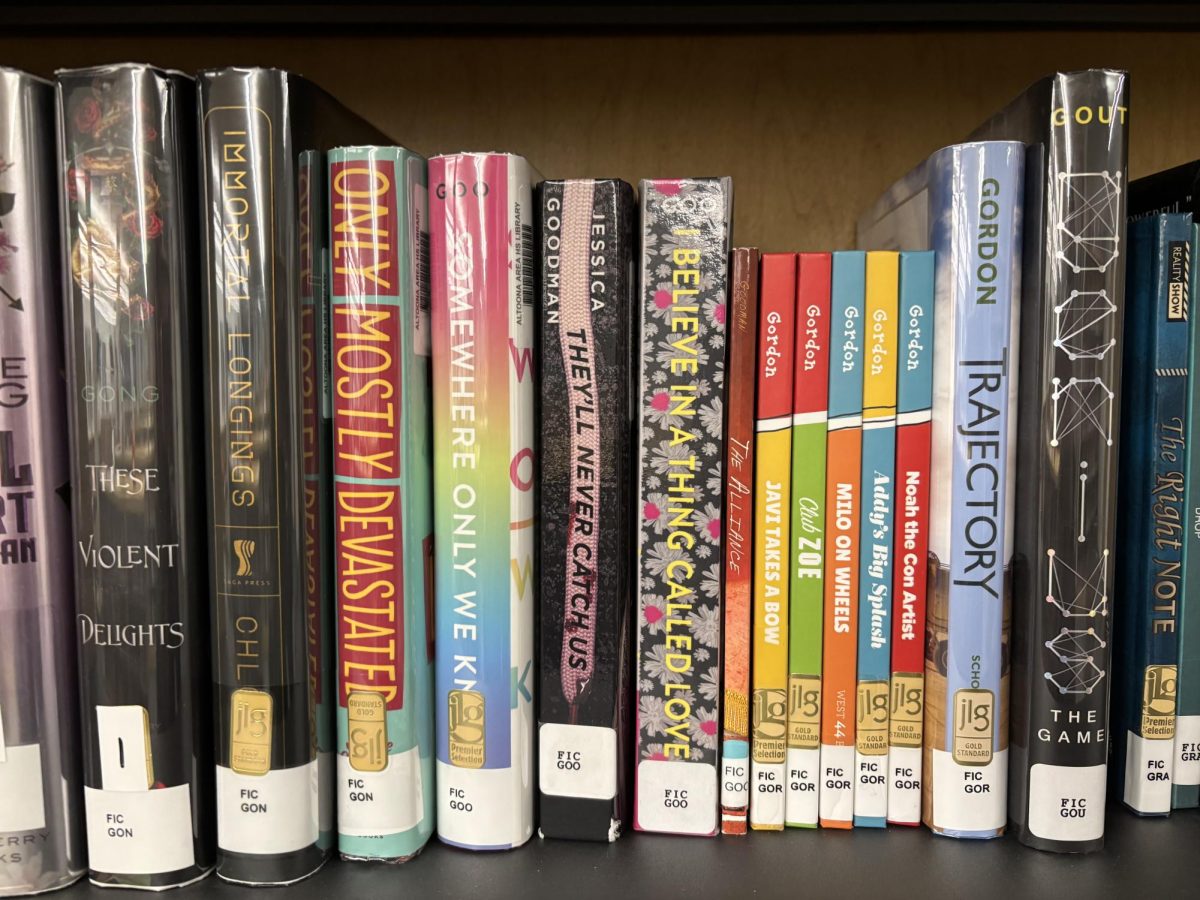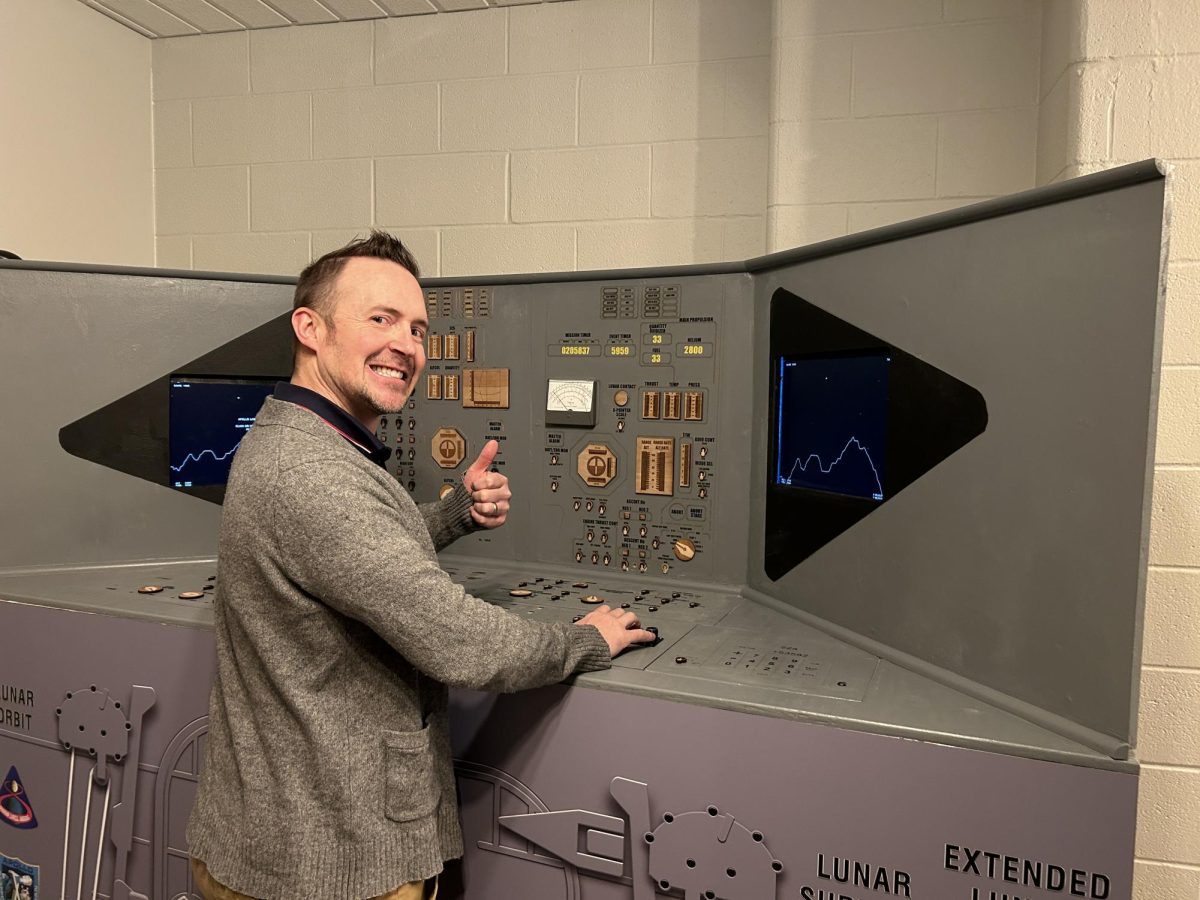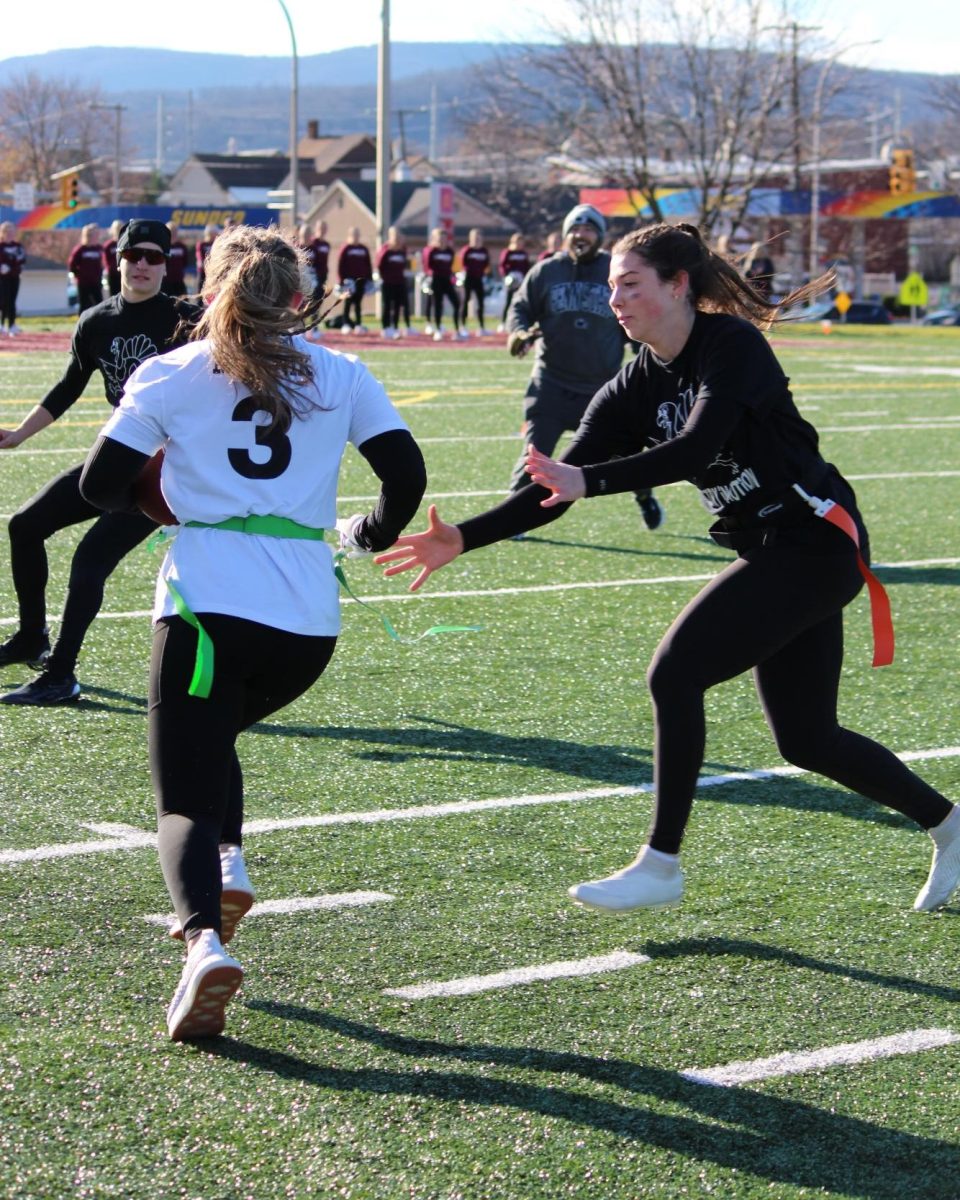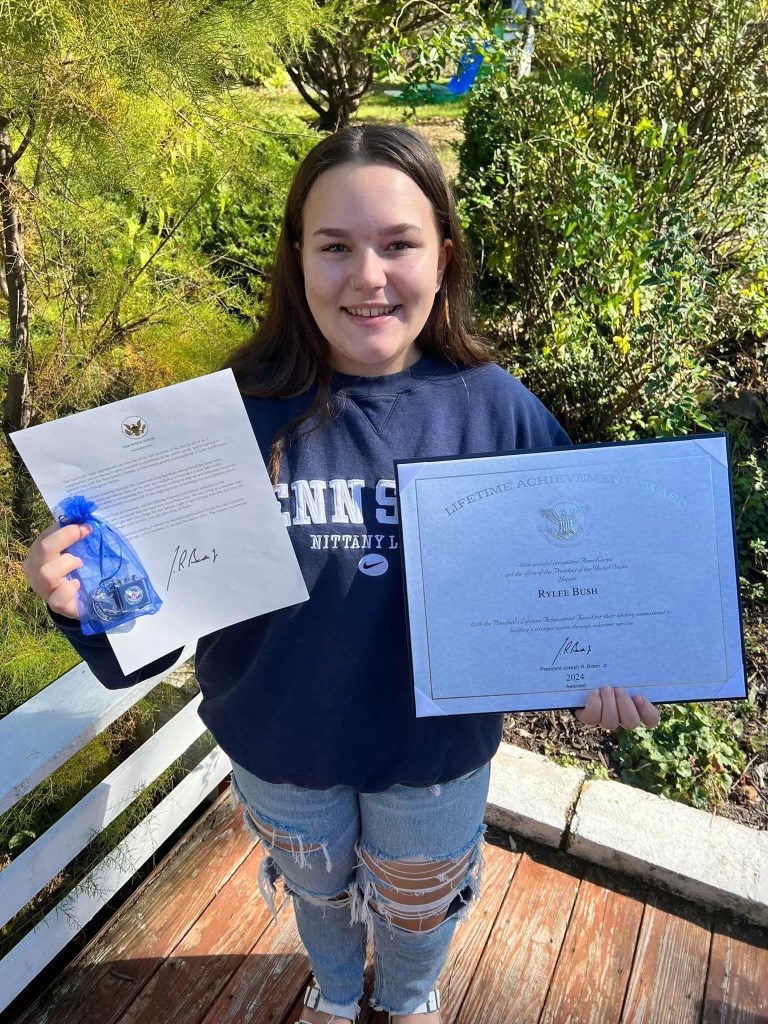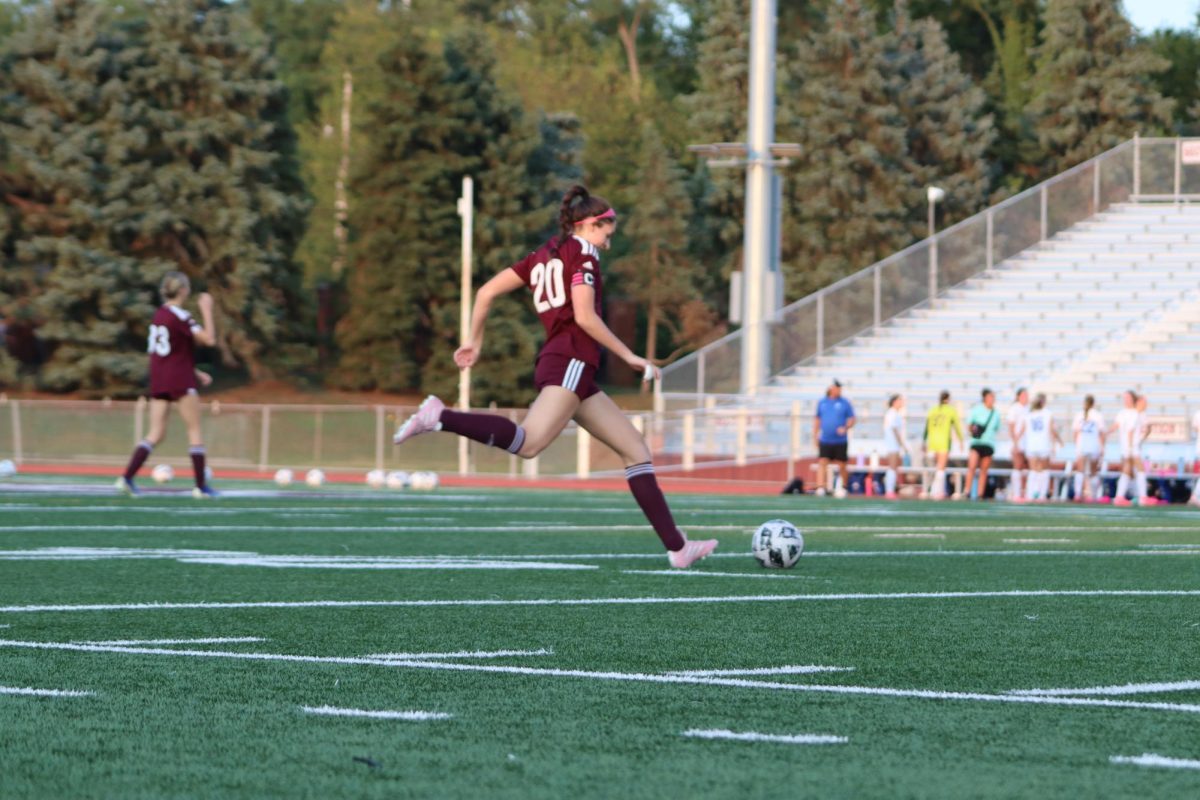Almost 25 years after her death, R. Scott’s parents, Darrell and Sandy, founded Rachel’s Challenge. R. Scott said her kindness was like a chain reaction, and over 20 years later, the longest paper chains on Earth prove she was right. National Director Kelly Campman helps to reach out to schools to join the challenge. Art in Public Spaces students recently painted a mural inside the Rachel’s Closet store in honor of R. Scott and attended a Zoom meeting with D. Scott before the grand re-opening.
Campman now helps with the challenge almost 25 years later.
“Their goal was to honor the legacy of Rachel by sharing the insightful writings from her journals,” Campman said. “Their goal was to share her thoughts and words to inspire students to learn by her example of accepting others and treating them with kindness. Rachel believed that those positive behaviors would save lives, and for many students and schools, Rachel’s Challenge has done just that. We hear from over 150 students each year that decided not to harm themselves or others. Although we know our work is not done, we celebrate these successes.”
Students in the Art in Public Spaces painted a mural inside of Rachel’s Closet. One of the signs on the mural was 13 doves representing the 13 lives lost in the massacre.
“It is evident that the students were personally impacted by Rachel’s Challenge based on the details they included in the mural,” Campman said. “The hands that were traced on the back of Rachel’s dresser. The journals and the drawing of Rachel’s eyes. The chain links of kindness that are now represent the chain reaction of kindness in schools. All of these images represent Rachel’s story, and the impact it had on the students of Altoona.”
Individuals can contact their local schools and share community needs. They can also donate resources to assist the FOR Clubs with their service projects.
“Rachel’s Challenge and Rachel’s story is so powerful in itself, but by sharing stories of projects or successes that schools and FOR Clubs have experienced, we can inspire others to want to do the same,” Campman said. “We share those in our educator newsletter called RC Connection and in our link to the RC Club Hub, which are shared with FOR Club leaders.”
One of the many successful stories Campman has heard of is the grand re-opening of the AAHS Rachel’s Closet.
“These stories reflect the students’ desire to truly make positive changes in their schools,” Campman said. “We just recently heard a story about a teacher/FOR Club Leader who had to go on leave for brain surgery. When she came back, her students showered her with kindness. She shared her story with her students, and a student later came up to tell her that his mom was also very sick. By sharing her story, this student felt the trust and connection to share his. This gave the teacher and all of her students a catalyst to have deeper connections within their classroom. We love hearing these types of stories where Rachel’s Challenge has impacted their lives in and outside of the school building.”
Individuals can contact their local schools to help Friends of Rachel clubs.
“They can also donate resources to assist the FOR Clubs with their service projects,” Campman said. “They can also volunteer to help the FOR Clubs with their projects or with supervision on field trips or volunteer to be guest speakers for the FOR Club meetings.”
The FOR Club is a student-led organization created to empower students to cultivate a culture of kindness and compassion within their school and community.
“Through a commitment to service and leadership, members strive to inspire meaningful change and foster inclusive environments where every individual feels valued and supported,” Campman said.
Campman became the National Director by being a principal of an elementary school that had a thriving Rachel’s Challenge KC (Kindness and Compassion) club for many years.
According to Campman, after 26 years in education, Campman felt that she could make a greater impact by supporting schools in their efforts to improve their schools’ cultures, especially in a world where we have seen and felt such division.
“In my role at Rachel’s Challenge, I reach out to schools to support and coach them as they create their KC and FOR Clubs,” Campman said. “I share resources from FOR Clubs across the country in our RC Club Hub link, RC Connection Newsletter, on social media, on Zoom calls, and through personal email or phone communication. I am so thankful that I am able to use my experience to inspire FOR Club leaders to work with students to spread the philosophy of kindness, compassion and connection of Rachel’s Challenge and the impact their FOR Clubs will make in their schools.”
As a student adviser, senior Bella Getty helped plan the new mural by presenting Rachel’s story, including a video from Rachel’s brother, that she had presented to the club earlier in the year, to Mrs. Curry’s art in public places students, so they could get a sense of what they needed to express when creating the mural.
“Mrs. Lucas, the librarian and one of the co-leaders of the club, and I took the students to see the wall where they would complete the mural,” Getty said. “During this visit, we discussed the key ideas to include in the mural, such as the chain, Rachel’s writings and drawings, a sense of open space to make the closet feel bigger, and Rachel herself.”
Getty believes the mural will help students feel a sense of connection.
“It highlights many important aspects of Rachel’s legacy, such as kindness, compassion, and connectivity,” Getty said. “The purpose of this mural is to serve as a reminder of the reason why we started this club in the first place, which is to prevent violence by promoting kindness. I hope that students will feel empowered by the messages conveyed through this mural. The primary goals or objectives of the Friends of Rachel Club is to ‘Be a Friend to those who Need a Friend’ by going out of our way to help everyone feel like they belong.”
According to Getty, the club supports students in fostering kindness and inclusion within the school community by sharing ideas to promote compassion.
“We follow through by making cards for the elderly, drawing positive words with chalk on the sidewalks, writing letters to new students, and many other kindness activities,” Getty said.
The club is dedicated to honoring Rachel Scott’s legacy and promoting her message of compassion and positivity by spreading kindness.
Getty encourages those who are already members of the club to share their ideas for future activities in the Google Classroom.
“If anyone who is not a part of the club has any ideas to contribute, they can send an email to me or Mrs. Lucas, and we can discuss them further,” Getty said. “We plan to continue this club for a long time, and we hope that more people will join us next school year and bring new ideas to make our school community a more compassionate place.”
One of the FOR club advisers, Tanya Lucas, helps the group promote their projects throughout the school.
“This group is committed to promoting respect, acceptance and appreciation for all students and members of our community,” Lucas said. “Our mission is to create a community of leaders who care about the well-being of fellow students: where students feel safe, value others, and know they are never alone. Students in this group promote and support a variety of activities within the schools in the district to create an awareness and caring environment for all people. The best way to support the Friends of Rachel is to show kindness and compassion to yourself and others.”
Other than renovating the closet, Lucas had some other plans in mind.
“In addition, the club created and delivered cards during the holidays to nursing homes, created and sent inspirational posters to Operation Gratitude, wrote letters welcoming our new students, welcomed new students at lunch at the Friends of Rachel tables and created sidewalk art and positive messages for students to see as they enter our school,” Lucas said. “Join the club. Donate clothing, personal hygiene, and school supplies to the closet.”
Last spring, the club asked Kathryn Curry if she would consider creating the mural with her Art in Public Places students.
“When entering the Friends of Rachel’s Closet, it just feels welcoming and peaceful,” Lucas said. “It is also a visual reminder that we need to be compassionate and kind toward ourselves and each other. Through kindness and compassion, we hope to create a community where all students feel welcomed, accepted, and safe.”
The club hopes to have the Rachel’s Challenge speaker/s back to the District next year.
“Their message was powerful, but most kids don’t remember the dynamic speakers our District had in the past,” club adviser Julie Yahner said. “We may have them back to our District next Fall, but we are just in the beginning stages of planning. This will be like a shot in the arm that we may need to remember the importance of treating our peers and neighbors with respect. Other plans include keeping the Closet running and updating as much as possible.”
The club tries to keep the pulse of the school and remain aware of certain areas that may need attention.
“During our meetings, we try to gauge what kids may be struggling with and brainstorm ways to manage things and improve upon,” Yahner said.
Students use the FOR Google classroom to connect with one another, and it is also a way for them to send reminders about meetings and upcoming events.
“It’s always nice for us to see on there that kids will boost each other up and offer encouraging words to their peers,” Yahner said. “Our club members in general should be a friendly face to anyone struggling as we offer encouraging positive words for those who may need them.”
When the club got the new room last school year, the planning of the mural began.
“Mrs. Curry was eager to help and suggested the Artist in Residence Grant,” Yahner said. “We knew we wanted to feature Ms. Rachel Scott in the mural. We try to keep her memory and legacy alive in our club.
The mural will be a reminder that small acts of kindness can make a big impact in someone’s life.
Curry used perspective to create depth so it felt like you could step out into this dreamlike space Rachel is in.
“The main inspiration behind the design was promoting kindness through Rachel Joy Scott,” Curry said. “We were asked to include her in it so she is standing on the left side releasing doves (one for each student who died from Columbine HS). The doves turn into pages of her notebook that she wrote and drew in. There are paper chains on the sides representing the chain reaction of kindness as well. Physically, the room is small with no windows so we wanted to feel like the room was bigger than it actually was.”
The students in Curry’s Art for Public Places class designed individual ideas for the mural and worked alongside Artist in Residence, Deb Bunnell, to create a collaborative piece.
“The project was funded by Southern Alleghenies Museum of Art and the Altoona Foundation,” Curry said. “Without their support, the mural would not have been possible.”
Curry hopes people can take a piece of kindness from Rachel and pass it on.
Curry and students spent over 30 days designing, drawing and painting this mural so there are memories and time spent in Rachel’s Closet.
“I think my personal favorite part of working on the mural was working alongside a professional artist and learning artists,” Curry said. “Having an artist in residence provides a unique experience where I am both a learning artist and teaching artist. I am basically the bridge between my students and the artist. I love practicing my craft while learning new things.”
According to Curry, they had a slow start to working in Rachel’s Closet due to maintenance.
“Administrators wanted the boards removable just in case they ever needed to move locations,” Curry said. “This required boards to be mounted onto the wall and then painted with a coat of white primer. This set us back about a week in production. We had to make up for it in the end and quickly finish to fit within Deb’s 30 day residency.”
Scott was the inspiration behind the mural and behind Rachel’s Closet in general.
“This ‘up-cycled’ version of Rachel’s Closet was in development long before I became part of it,” Bunnell said. “Tanya Lucas, librarian, and Julie Yahner, guidance counselor, plus students in the Rachel’s Challenge club were instrumental in seeing this through.”
When Curry was contacted about doing a mural with her students, she contacted Bunnell and arranged a residency through the Southern Alleghenies Museum of Art (SAMA), so Bunnell could work with her Art in Public Places class to create the mural.
“We saw a presentation about Rachel, and then brainstormed about what to include in the mural,” Bunnell said. “We decided to include some of her writings. The pages of her writings seem to fly out of the notebook, and then in the air, they turn into 13 doves, which signify the number of students killed at Columbine. One of her pages was just a drawing of eyes whose tears water a rose. (This was done right before the shooting, and she drew 13 tears on it.) She had an uncanny sense of the future when she traced her hands and wrote on them: ‘These hands belong to Rachel Joy Scott and will someday touch millions of lives.’ In the mural, Rachel holds a rose. I then drew up the design and projected it on the wall while students traced it on. We all painted it then.”
With perspective, the mural gives a sense of space, making the room seem bigger than it is.
“Those who take the time to look closely will get to know Rachel better, and hopefully will take to heart her message about the ‘chain of kindness.’ Also, the mural contributes to the upscale appearance of the room,” Bunnell said. “It is a pleasant and inviting place to ‘shop’ for items a student may need.”
Scott was known for befriending everyone in the school.
“Students who may need clothing or other necessities are made to feel welcome and accepted,” Bunnell said. “Anyone, not just the disadvantaged, is welcome to use or donate to Rachel’s Closet, which aims to establish a culture of ‘upcycling’ clothing instead of discarding and buying new clothing constantly.”
Some of our student artists ended up specializing in certain aspects of the mural – painting wisteria up high near the ceiling or sitting on the floor painting roses.
“We had paper chain painters, column painters, and vine painters,” Bunnell said. “We were all touched by Rachel’s handprint message, so I got everyone’s handprints worked into the rose bushes, including mine, Mrs. Curry’s, and the two students who work in Rachel’s Closet. When we had everyone working, there was just enough room to squeeze us all across the wall.”
Students and Bunnell had to paint on boards attached to the wall by the school because the district doesn’t want artwork that cannot be moved if needed.
“So, instead of painting on mural cloth in the classroom (like the lobby mural) then installing it, we painted directly on the boards on the wall,” Bunnell said. “This required some extreme painting positions – scrunched up on the floor, or stretched to the max to reach up high, even on a ladder. Most of us turned out to be pretty flexible.”



